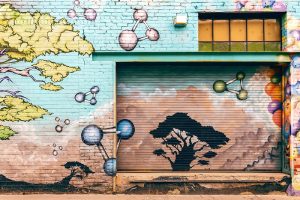 Montserrat Crespi-Vallbona, Associate Professor at the Department of Business and UB Business School researcher, and Oscar Mascarilla Miró, researcher of the UB School of Economics, are the co-authors of an article titled “Street Art as a Sustainable Tool in Mature Tourism Destinations: A Case Study of Barcelona”. Recently published in the scientific journal International Journal of Cultural Policy, it focuses on the idea that tourism needs both an urgent innovation and creativity to keep its boom going.
Montserrat Crespi-Vallbona, Associate Professor at the Department of Business and UB Business School researcher, and Oscar Mascarilla Miró, researcher of the UB School of Economics, are the co-authors of an article titled “Street Art as a Sustainable Tool in Mature Tourism Destinations: A Case Study of Barcelona”. Recently published in the scientific journal International Journal of Cultural Policy, it focuses on the idea that tourism needs both an urgent innovation and creativity to keep its boom going.
The current tendency to live experiences and emotions by tourists, moving away from their daily routine, makes urban art such an important cultural resource to be considered. According to the authors, such holistic experiences should include hedonism, participation, local identity, knowledge, tasting, and nostalgia. “Hedonism is an intrinsic component of any tourist activity as visitors basically seek moments of enjoyment”, Montserrat Crespi said. “Participation is capital, an idea far removed from contemplative tourist, to make dynamic and interactive activities that also include cognitive actions to be learned”, she added.
The results of the study suggest that local identity must also be part of tourists’ experiences, by keeping them away from globalisation or tasting local products, which has a crucial impact on satisfying experiences and means a much more real cultural immersion. Finally, nostalgia is also included in touristic activities; when personal and intimate feelings of the past are evoked, the satisfaction and experience of the moment are reinforced.
The objective of this study was to evaluate the so-called project Pinacoteca a Cel Obert (Open-Air Art Gallery), an innovative street art movement that involves the local community as part of the local government’s drive to encourage community participation and empower change regarding urban issues.
Since 2012, Barcelona City Council has been using street art as an instrument of social and urban transformation in different neighbourhoods with the aim of revitalising them economically, and also building a sense of community and belonging among their inhabitants. Thus, Pinacoteca a Cel Obert arrived as a new experience of cultural and tourist consumption in public space. It consists of 24 murals painted on the blinds of local stores that reproduce famous classic pieces of art history in order to revive, both economically and culturally, a commercial area of Barcelona without tourism, beautifying the public space and positioning it as a new tourist attraction away from the congested area of the city centre.
The research analyses the viability and sustainability of this commendable example through in-depth interviews with the different project managers, the guides who run the tours, and the visitors who have participated in them.